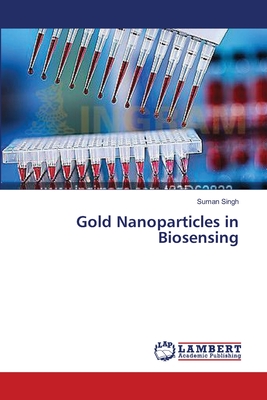
Gold Nanoparticles in Biosensing
Paperback
Currently unavailable to order
Please enter your email and a message will be sent to you when this product becomes available on our website.
ISBN13: 9783659510823
Publisher: Lap Lambert Academic Pub
Published: May 20 2014
Pages: 180
Weight: 0.60
Height: 0.41 Width: 6.00 Depth: 9.00
Language: English
Also in
Chemistry
Everything Is Tuberculosis (Signed Edition): The History and Persistence of Our Deadliest Infection
Green, John
Hardcover
Everything Is Tuberculosis: The History and Persistence of Our Deadliest Infection
Green, John
Hardcover
The Iceman Inheritance: Prehistoric Sources of Western Man's Racism, Sexism and Aggression
Bradley, Michael
Paperback
BioGeometry Signatures: Harmonizing the Body's Subtle Energy Exchange with the Environment
Karim Dr Sc, Ibrahim
Paperback
Princeton Review AP Chemistry Premium Prep, 26th Edition: 7 Practice Tests + Digital Practice Online + Content Review
The Princeton Review
Paperback
AP Chemistry Premium, 2025: Prep Book with 6 Practice Tests + Comprehensive Review + Online Practice
Kerrigan, Pamela
Barron's Educational Series
Jespersen, Neil D.
Paperback
Liquid Soapmaking: Tips, Techniques and Recipes for Creating All Manner of Liquid and Soft Soap Naturally!
Thompson, Jackie
Paperback
The Flavor Matrix: The Art and Science of Pairing Common Ingredients to Create Extraordinary Dishes
Briscione, James
Parkhurst, Brooke
Hardcover
Sciencia: Mathematics, Physics, Chemistry, Biology, and Astronomy for All
Betts, Moff
Tweed, Matt
Watkins, Matthew
Hardcover
The Science of Cleaning: Use the Power of Chemistry to Clean Smarter, Easier, and Safer-With Solutions for Every Kind of Dirt
Bressanini, Dario
Paperback
The Elements: An Illustrated History of the Periodic Table (100 Ponderables) Revised and Updated
Jackson, Tom
Hardcover
Superfoods, Silkworms, and Spandex: Science and Pseudoscience in Everyday Life
Schwarcz, Joe
Paperback
Stuff Matters: Exploring the Marvelous Materials That Shape Our Man-Made World
Miodownik, Mark
Paperback
Periodic Tales: A Cultural History of the Elements, from Arsenic to Zinc
Aldersey-Williams, Hugh
Paperback
5 Steps to a 5: AP Chemistry 2025: Practice AP Tests + AP Content Review + Digital Exams
Moore, John T.
Paperback
Elements: A Visual Exploration of Every Known Atom in the Universe, Book 1 of 3
Gray, Theodore
Hardcover
Visual Learning: Chemistry: An Illustrated Guide for All Ages
Sezer, Ali O.
Barron's Educational Series
Paperback
Reactions: An Illustrated Exploration of Elements, Molecules, and Change in the Universe
Gray, Theodore
Paperback
Race for a Remedy: The Science and Scientists Behind the Next Life-Saving Cancer Medicine
Ahmed, Makhdum
Hardcover
Science and Cooking: Physics Meets Food, from Homemade to Haute Cuisine
Brenner, Michael
Sörensen, Pia
Weitz, David
Hardcover
Periodic Table Poster (24 X 36 Inches) - Laminated: A Quickstudy Chemistry Reference
Jackson, Mark
Other
Essential Thermodynamics: An undergraduate textbook for chemical engineers
Panagiotopoulos, Athanassios Z.
Paperback
The Telomere Effect: A Revolutionary Approach to Living Younger, Healthier, Longer
Epel, Elissa
Blackburn, Elizabeth
Paperback
Modern Quantum Chemistry: Introduction to Advanced Electronic Structure Theory
Szabo, Attila
Ostlund, Neil S.
Paperback
Schaum's Outline of Organic Chemistry, Sixth Edition
Nechamkin, Howard
Sharefkin, Jacob
Meislich, Herbert
Paperback
The Telomere Effect: A Revolutionary Approach to Living Younger, Healthier, Longer
Blackburn, Elizabeth
Epel, Elissa
Hardcover
Reactions: An Illustrated Exploration of Elements, Molecules, and Change in the Universe, Book 3 of 3
Gray, Theodore
Hardcover
Dr. Joe and What You Didn't Know: 177 Fascinating Questions & Answers about the Chemistry of Everyday Life
Schwarcz, Joe
Paperback
An Introduction to Error Analysis: The Study of Uncertainties in Physical Measurements
Taylor, John R.
Paperback
Liquid Rules: The Delightful and Dangerous Substances That Flow Through Our Lives
Miodownik, Mark
Paperback
Chemistry: Concepts and Problems, a Self-Teaching Guide
Houk, Clifford C.
Post, Richard
Snyder, Chad
Paperback
The Absolute Guide to DMT Extraction: Sources, Methods of Extraction, and Potential Therapeutic Benefits
Ashford, Simon
Paperback
Princeton Review AP Chemistry Prep, 25th Edition: 4 Practice Tests + Complete Content Review + Strategies & Techniques
The Princeton Review
Paperback
Science Fundamentals 3 - Physical Science: Quickstudy Laminated Reference & Study Guide
Gardner, Jane
Other
Dopamina: Cómo Una Molécula Condiciona de Quién Nos Enamoramos, Con Quién Nos Acostamos, a Quién Votamos Y ... / The Molecule of More
Lieberman, Daniel Z.
Long, Michael E.
Paperback
Chemistry All-In-One for Dummies (+ Chapter Quizzes Online)
Hren, Christopher R.
Moore, John T.
Mikulecky, Peter J.
Paperback
Molecular Biology: Principles of Genome Function
Green, Rachel R.
Greider, Carol C.
Craig, Nancy L.
Paperback
Statistical Mechanics and Stochastic Thermodynamics: A Textbook on Modern Approaches in and Out of Equilibrium
Limmer, David T.
Hardcover
A Practical Manual for Transcranial Magnetic Stimulation
Fried, Peter J.
Davila-Pérez, Paula
Edwards, Dylan J.
Hardcover
Balancing Chemical Equations Worksheets (Over 200 Reactions to Balance): Chemistry Essentials Practice Workbook with Answers
McMullen, Chris
Paperback
Ap(r) Chemistry Crash Course, Book + Online: Get a Higher Score in Less Time
Dingle, Adrian
Paperback
Illustrated Guide to Home Chemistry Experiments: All Lab, No Lecture
Thompson, Robert Bruce
Paperback
Laboratory Experiments for Chemistry: The Central Science
Brown, Theodore
Lemay, H.
Bursten, Bruce
Paperback


 Sign-In
Sign-In Cart
Cart